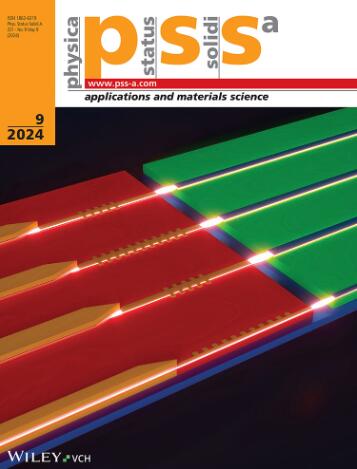Green Sonochemical Synthesis of rGO Nanosheets‐Decorated by SnO2 Nanoparticles for Nitrogen Gas‐Sensing Applications
IF 1.9
4区 材料科学
Q3 MATERIALS SCIENCE, MULTIDISCIPLINARY
Physica Status Solidi A-applications and Materials Science
Pub Date : 2024-07-05
DOI:10.1002/pssa.202400267
引用次数: 0
Abstract
In recent years, the development of efficient and environmentally friendly synthesis methods for nanomaterials has gained significant attention in various research fields, particularly in gas‐sensing applications. Among these methods, ultrasonic synthesis stands out for its simplicity, cost‐effectiveness, and ecofriendly nature. Herein, a simple and green ultrasonic synthesis process is used to synthesize the SnO利用二氧化硫纳米粒子对氮气传感应用中的 rGO 纳米片进行绿色声化学合成
近年来,高效、环保的纳米材料合成方法的开发在各个研究领域,尤其是气体传感应用领域受到极大关注。在这些方法中,超声合成以其简单、成本效益高和生态友好的特点脱颖而出。本文采用简单、绿色的超声合成工艺合成了SnO2纳米颗粒装饰的rGO纳米片。所获得的 X 射线衍射图显示了四方金红石型晶体结构。透射电子显微镜图像显示了 rGO 片表面的二氧化锡纳米粒子装饰。在 rGO 片材表面发现了尺寸为 4-8 纳米的 SnO2 纳米颗粒。此外,纳米复合材料的光吸收和光致发光光谱验证了二氧化锡和 rGO 片材界面上发生的电荷迁移。与原始的 SnO2 纳米粒子相比,绿色超声合成的 SnO2 纳米粒子装饰的 SnO2/rGO 纳米复合材料对二氧化氮气体具有更好的传感性能,在 200 °C 下对二氧化氮气体具有选择性。SnO2/rGO 纳米复合材料具有很高的二氧化氮传感性能,同时还具有极佳的响应性(400 ℃ 时为 67%)、快速反应时间(18 秒)和较短的恢复时间(25 秒)等吸引人的传感特性。
本文章由计算机程序翻译,如有差异,请以英文原文为准。
求助全文
约1分钟内获得全文
求助全文
来源期刊
CiteScore
3.70
自引率
5.00%
发文量
393
审稿时长
2 months
期刊介绍:
The physica status solidi (pss) journal group is devoted to the thorough peer review and the rapid publication of new and important results in all fields of solid state and materials physics, from basic science to applications and devices. Among the largest and most established international publications, the pss journals publish reviews, letters and original articles, as regular content as well as in special issues and topical sections.

 求助内容:
求助内容: 应助结果提醒方式:
应助结果提醒方式:


